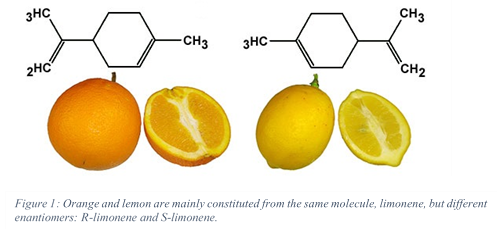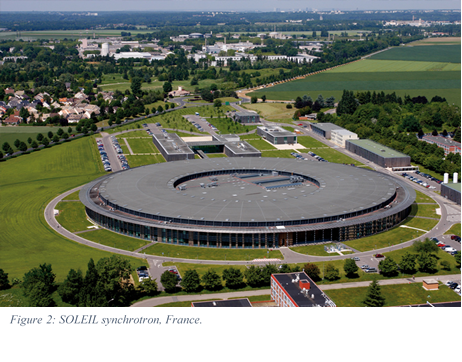PECD: a probe of molecular chirality
Written by: Hassan Ganjitabar
October 26, 2018
Molecular structure is important in determining the characteristics of a compound. Different enantiomers, or molecules with the same composition but structurally are mirror images of one another, are responsible for different tastes and smells. A good example of this is the different taste of lemon and orange. While both of them are from the chiral limonene molecule, they are enantiomers of each other (Figure 1). Photoelectron Circular Dichroism (PECD) has been used recently as a tool to probe molecular chirality (i.e. determine which enantiomer it is, R or S). The PECD signal has opposite signs for a pair of molecular enantiomers. If we go back to our lemon and orange example, the PECD signal for orange could be positive whereas the PECD signal for lemon would be negative. Therefore PECD measurements of a mixture of two enantiomers can be indicative of the taste and the smell of the mixture.

The example of orange and lemon is simple as they are enantiomers of one molecule; however, in the food industry people are interested in more complex mixtures. These mixtures are composed of several different chiral molecules present in both enantiomeric shapes, meaning more than two molecular entities are present. Lemon oil and lime oil are two examples of these types of mixtures. These oils contain molecules from the monoterpene family like limonene, alpha-pinene, beta-pinene, sabinene, and 3-carene. This poses a challenge for industry to use PECD as a means to understand the taste and smell of a particular mixture.
In one part of our research, we are looking for an analytical method to use PECD as a simultaneous probe of enantiomer excess of all main compounds in a mixture like lime and lemon oil. At the moment there are some established methods, like GC2, to measure the enantiomer excess of different molecules inside mixtures, but their sensitivity in diluted samples in gas phase is low. In contrast, photoelectron spectroscopy (PES), and consequently gas phase PECD measurements, has shown a high sensitivity when applied to gas phase mixtures. To measure enantiomer excess, we are using circularly polarised light (CPL) generated by the third generation synchrotron facilities (SOLEIL, France). The synchrotron facilities have been able to generate useful sources of light for around two decades. In addition to CPL, the facilities can provide high energetic photons capable of producing single photon ionisation of all molecules of our interest. CPL, can be polarised in either direction, left or right. CPL can therefore be used as a reference chiral object interacting with the chiral molecules in the mixture to measure their chirality.

In another part of the project, we are interesting in the resonantly enhanced multiphoton ionisation (REMPI-) PECD. Every molecule has unique vibrational/electronic states which can be considered the fingerprint of that molecule. PECD has been known to show more sensitivity to such properties of the molecules. Using the REMPI technique in PECD measurements, more detailed information about a molecule’s fingerprint can be determined. This is because REMPI enables a researcher to study the effect of different molecular properties on PECD from which vibrations [1], intermediate states [2, 3] and the molecular dynamics [4] can be inferred. Therefore this research is looking for potential uses of PECD as a probe of the molecular ultrafast quantum dynamics as well as the intermediate state electronic and vibrational states.
Suitable light sources for REMPI-PECD are ultrafast pulsed lasers. In one our recent experiments at the Artemis beamline of Central Laser Facility (UK), we measured the PECD of alpha pinene in a REMPI mode at multiple wavelengths. Alpha-pinene was chosen for this experiment as it is one of the main compounds that can be found in the essential oils discussed above. Additionally, alpha-pinene was chosen for practical reasons because it has shown the highest PECD signal that has been ever recorded in our previous synchrotron based experiments. By tuning the wavelength in the REMPI-PECD experiment, we can pump specific vibronic intermediate states and then ionise the photoelectrons from that state. In this way, information about the different vibronic states of the molecule and how the PECD signal is depends on them can be obtained.
Personal Experience as an Early Stage Researcher
Being a part of ASPIRE, a Marie Skłodowska-Curie ITN network, has been a delightful experience as the network provides great opportunities to the ESRs (researchers). As an ESR, I am able to attend regular meetings with ASPIRE partners and associates. These meetings help me improve my communication and networking skills. I also receive valuable training through secondments I have attended through the network. The experience of being a member of such a big project is quite new and exciting. It has allowed me to be in contact with a group of people with diverse and innovative ideas which helps young researchers, like me, to grow as scientists in a specific field.
References
1. M., R.F.M., et al., Intense Vibronic Modulation of the Chiral Photoelectron Angular Distribution Generated by Photoionization of Limonene Enantiomers with Circularly Polarized Synchrotron Radiation. ChemPhysChem, 2018. 19(8): p. 921-933.
2.Fanood, M.M.R., M.H.M. Janssen, and I. Powis, Wavelength dependent photoelectron circular dichroism of limonene studied by femtosecond multiphoton laser ionization and electron-ion coincidence imaging. The Journal of Chemical Physics, 2016. 145(12): p. 124320.
3.Kastner, A., et al., Intermediate state dependence of the photoelectron circular dichroism of fenchone observed via femtosecond resonance-enhanced multi-photon ionization. The Journal of Chemical Physics, 2017. 147(1): p. 013926.
4. Comby, A., et al., Relaxation Dynamics in Photoexcited Chiral Molecules Studied by Time-Resolved Photoelectron Circular Dichroism: Toward Chiral Femtochemistry. The Journal of Physical Chemistry Letters, 2016. 7(22): p. 4514-4519.